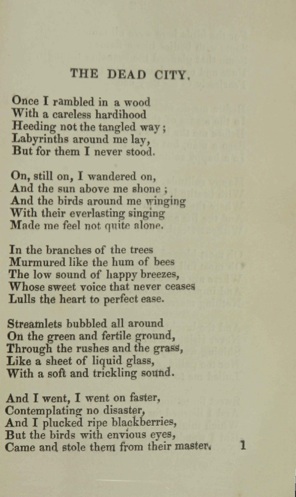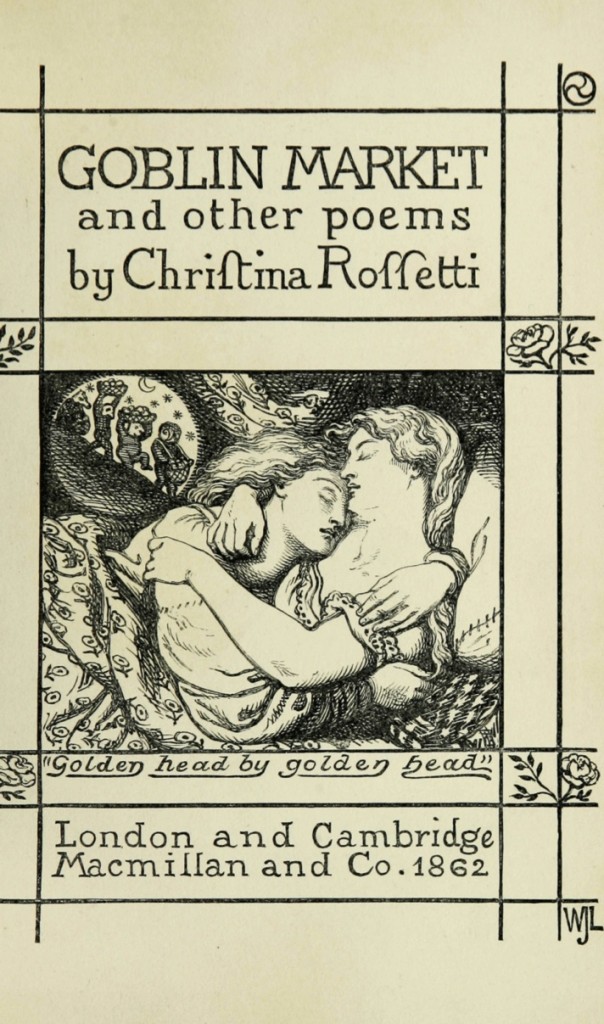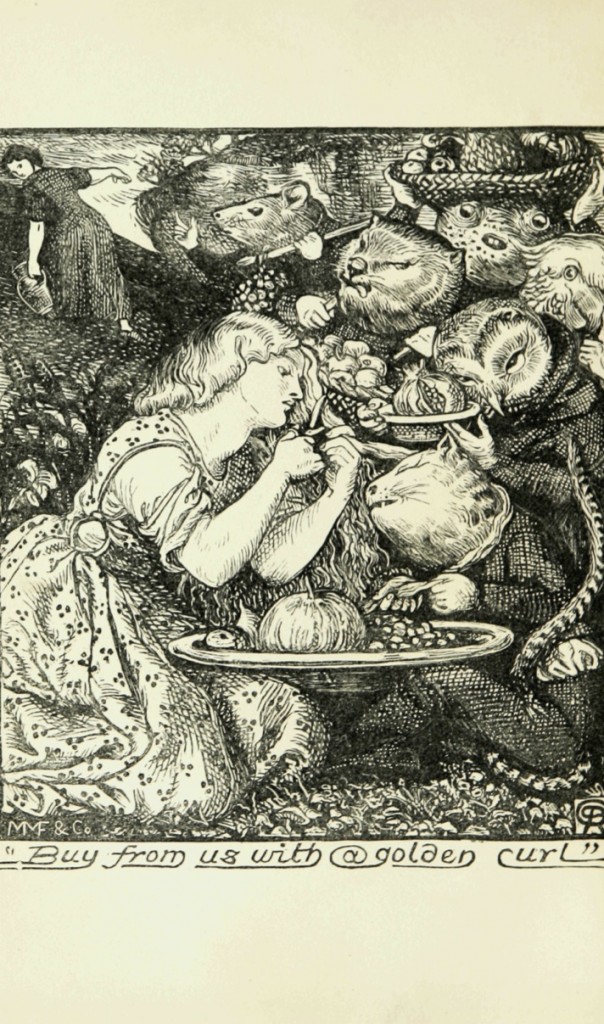Christina Rossetti
Verses. London: Privately printed at G. Polidori’s, 1847 (ABLibrary 19thCent PR5237.V4 1847)
Goblin Market and Other Poems 1862 First edition (ABLibrary 19thCent PR5237.G6 1862)
Rare Item Analysis:
by Chelsea Lee
Christina Rossetti, most easily recognized and regarded for her poem “Goblin Market,” is one of the English Victorian Era’s most prominent female poets. Verses, “composed from the ages of twelve to sixteen” (preface) and published in 1847 through the funding of her grandfather, contains some of Rossetti’s earliest poems. One of these poems, “The Dead City,” when read in conjunction with “Goblin Market,” can easily been seen as a precursor to her later, masterful work of “Goblin Market”—first published in a collection titled Goblin Market and Other Poems, published in 1862. Digital copies of both collections, Verses and Goblin Market and Other Poems can be found online at the following links, respectively:
http://digitalcollections.baylor.edu/cdm/compoundobject/collection/ab-wpc/id/11449/rec/10
http://digitalcollections.baylor.edu/cdm/compoundobject/collection/ab-wpc/id/20101/rec/1
Physical copies can also be found in the 19th Century Collection of the Armstrong Browning Library on Baylor University’s campus. Both of these items offer valuable insight on the original printing and reception of Christina Rossetti’s poetry, as well as her growth as a poet.
Verses, containing some of Rossetti’s earliest poetry, gives an interesting and valuable look into the early mind and craft of a young poet. Contained within the collection is a poem titled “The Dead City.” This poem foreshadows techniques and topics Rossetti would later pursue in “Goblin Market.” The poem, written in first-person singular, tells the story of an assumedly young female narrator traveling through the labyrinth of a seemingly abandoned, or “dead,” city in a dream vision of sorts. Eventually, the narrator encounters a type of mausoleum of a dinner laid out on a lavish table. During this scene, the narrator describes the foods laid on the table in a near litany of fruits:
Grapes were hanging overhead,
Purple, pale, and ruby-red;
And in panniers all around
Yellow melons shone, fresh found,
With the dew upon them spread.
And the apricot and pear
And the pulpy fig were there;
Cherries and dark mulberries,
Bunchy currants, strawberries,
And the lemon wan and fair. (186-195)
The lines I have sampled above are just two of the many stanzas included in this litany. This discourse is remarkably similar to the litany of fruits given by the Goblin Men in Rossetti’s later poem, “Goblin Market.”
‘Come buy our orchard fruits,
Come buy, come buy:
Apples and quinces,
Lemons and oranges,
Plump unpeck’d cherries,
Melons and raspberries,
Bloom-down-cheek’d peaches,
Swart-headed mulberries,
Wild free-born cranberries,
Crab-apples, dewberries,
Pine-apples, blackberries,
Apricots, strawberries;–
All ripe together’ (3-15)
Here, in her later poetry, it is clear that Rossetti has refined her writing as the same effect is accomplished—that of a repetitive litany that can only be read as a sort of entrancing chant. In the former excerpt, Rossetti displays a verbosity that dwindles to a careful, knowledgeable, and artful word choice by the writing of “Goblin Market.” Though further refined and succinct, these two selections display the same aim.
Written and published much later than Verses, Rossetti’s Goblin Market and Other Poems displays an older poet in Rossetti. The ABL’s first edition (call number: 19thCent PR5237 .G6) of this collection displays the original printing of “Goblin Market” as well as the two images created by Christina Rossetti’s brother, Dante Gabriel Rossetti. These two images, printed on the two pages directly preceding the opening of the poem (the image depicting the two sisters serves as the frontispiece of the poem), direct the reader towards a specific, sexual reading of the poem. This particular reading is driven mostly by the details in the front facing image—containing an image of Laura, the Goblin Men, and their fruits. This image contains overtly sexual imagery in the form of phallic shapes (present in the tail of one of the image’s most prominent Goblins), as well as subtler sexual imagery in the fruits and in the expressions on the faces of Laura and the Goblin Men. Though this interpretation is certainly present in the poem in the form of the ravishing done by the Goblin Men and Laura’s indulgence in the Goblin Fruits, it is not and should not be the only interpretation drawn by the reader. Though these images depict pivotal moments in the poem, their imagery and suggestion allows the reader to easily miss or ignore other, subtler interpretations of the poem intended by its author.
Both early and original printings of these poems, in Verses and Goblin Market and Other Poems provide valuable insight into Christina Rossetti’s development as a poet as well as the effects of specific images on the interpretation of a poem. Future scholars, teachers, and students might use these items to glean a greater understanding of the original reception of the poems. Verses, containing some of Rossetti’s earliest poems, provides a look into the interesting mind of a young poet. Goblin Market and Other Poems, containing the original printing of “Goblin Market” as well as D. G. Rossetti’s art pieces accompanying the poem, gives light to the earliest directed interpretations of “Goblin Market.”
 |
 |
 |
 |
 |
 |
